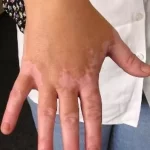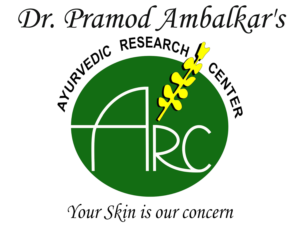Vitiligo
What is Vitiligo?

Vitiligo is a skin condition that causes loss of pigmentation or color in patches on the skin. It occurs when melanocytes, the cells responsible for producing skin color, are destroyed or stop functioning properly. The exact cause of vitiligo is not yet known, but it is believed to be an autoimmune disorder in which the body’s immune system attacks and destroys melanocytes.
Vitiligo can affect any part of the body, including the face, hands, arms, legs, and genital area. It can occur at any age, but often appears between the ages of 10 and 30. The patches of skin affected by vitiligo are usually white or depigmented, but may also be lighter or darker than the surrounding skin. The condition is not contagious or life-threatening, but it can cause significant psychological distress due to the cosmetic appearance of the skin.
Symptoms of Vitiligo
The primary symptom of vitiligo is the presence of depigmented or white patches on the skin. These patches may be small and localized or may gradually expand and merge to form larger areas of depigmentation. The edges of the patches may be well-defined or irregular in shape.
The affected skin areas may also have other characteristic features, such as:
- Premature whitening or graying of hair on the scalp, eyebrows, eyelashes, and beard
- Loss of color in the mucous membranes of the mouth and nose
- Loss of color in the retina of the eye
- Increased sensitivity to the sun, with a higher risk of sunburn and skin cancer
Causes of Vitiligo
The exact cause of vitiligo is not yet fully understood, but research suggests that it may be a result of a combination of genetic, environmental, and autoimmune factors.
Genetic Factors: Vitiligo can run in families, suggesting that certain genetic variations may increase the risk of developing the condition.
Autoimmune Factors: Many researchers believe that vitiligo may be an autoimmune disorder in which the body’s immune system mistakenly attacks and destroys melanocytes, the cells responsible for producing skin pigment.
Environmental Factors: Exposure to certain environmental triggers such as stress, sunburn, or exposure to certain chemicals may also play a role in the development of vitiligo.
Neural Factors: It has been suggested that certain neural factors, such as changes in nerve cells, could also contribute to the development of vitiligo.
Risk of Vitiligo
Vitiligo can affect anyone, regardless of age, gender, or ethnicity. However, some factors may increase an individual’s risk of developing the condition:
Family History: Vitiligo tends to run in families, and individuals with a family history of the condition are more likely to develop it themselves.
Autoimmune Disorders: People with autoimmune disorders, such as type 1 diabetes, rheumatoid arthritis, or thyroid disease, have a higher risk of developing vitiligo.
Age: While vitiligo can occur at any age, it most commonly develops in people aged between 10 to 30 years.
Ethnicity: People with darker skin tones, such as those of African, Hispanic, or Asian descent, have a higher risk of developing vitiligo compared to those with lighter skin.
Sunburn and Skin Trauma: Sunburn, skin trauma, or exposure to certain chemicals or toxins may increase the risk of developing vitiligo, particularly in people who are already predisposed to the condition.
Psychological Stress: Emotional stress, anxiety, or depression may also be a risk factor for developing vitiligo.
Ayurvedic Treatment for Vitiligo





